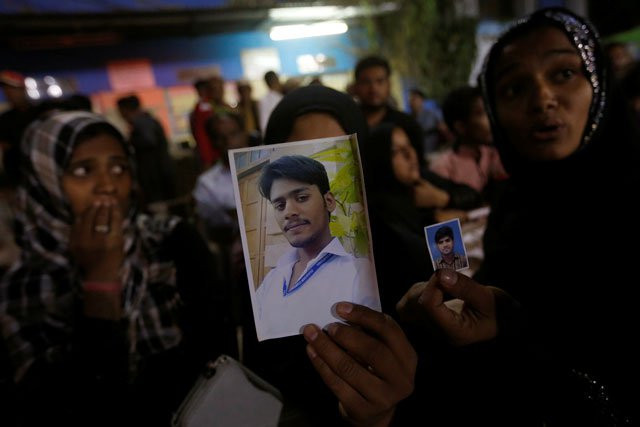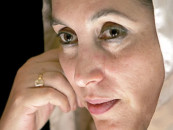Khuzdar shrine bombing: At saint’s abode, survivors relive the nightmare
Investigators find bullet casings at the site suggesting bomber might have used them in vest

Family members show pictures of missing relatives after an explosion in at the Shah Noorani Shrine in Baluchistan, outside a hospital in Karachi, November 12, 2016. PHOTO: REUTERS
The ceiling and pillars of the shrine’s covered courtyard, where the bomber blew himself up among a crowd of devotees performing dhamaal (devotional dance), is pockmarked with ball bearings and bullets, while traces of blood are visible on the hosed down floor which was littered with sandals and shawls of victims. Investigators sifted through these belongings to look for vital forensic evidence. They also scratched a bunch of hair off the ceiling believing they might have been of the bomber.
Da’ish forms nexus with other groups
Balochistan Home Minister Sarfraz Bugti said the bomber was a teenager, probably around 16 to 18 years of age. And investigators said he was carrying eight kilos of explosives in his vest which was packed with ball bearings and bullets. Khan Wassey, the spokesperson for paramilitary Frontier Corps, confirmed that investigators found bullets and cartridges from the bombsite, saying these might have been used in the suicide vest because there were no reports of firing before or after the bombing.
An explosives expert, however, said that the use of bullets in a suicide vest was something unheard of until now. “Bullets are heavy and add to the weight of the vest; therefore, mostly objects like ball bearings, pallets, nails and shrapnel are packed in suicide jackets to inflict maximum casualties,” he told The Express Tribune, requesting anonymity.
Medics at hospitals in Karachi where most of the casualties were brought lent credence to the expert’s view, saying that none of the victims had bullet wounds.
The devotees had trekked the treacherous mountainous terrain to reach the Shah Noorani shrine, situated on a hilltop, some 750 kilometres south of Quetta and some 140 kilometres north of Karachi, to pay their respects to the saint and seek blessing.
Shah Noorani blast: Kekra Trucks to the rescue
They told horrific tales of the nightmare. “The pressure of the blast was so strong, people were blown away. Everyone was running, shouting and searching for families,” said Muhammad Shehzad, a 25-year-old who had travelled in a group of 120 devotees: “Children were looking for the mothers and fathers. People looking for brothers and sisters but no one was able to listen to their cries.”
Hafeez Ali, a 28-year-old auto mechanic, said: “We had left the area only five minutes before the attack to go and cook our dinner. From our viewpoint on a hill, we could see three whirling dervishes dancing to a drummer, as hundreds formed a circle around them. Then came the explosion. “We realised that it was a bomb blast. Two of us rushed down and saw the bodies scattered all around — mostly children. We also saw the drum beater dead and his exploded drum was lying nearby.”
Survivors said problems were compounded by the fact that it took several hours for rescue services to reach the remote shrine, which is several kilometres away from surrounding villages, with no health facility nearby and poor mobile network coverage. Ambulances were sent from Quetta and Karachi to ferry the casualties while Pakistan Army also dispatched its troops and medics to help the victims. Aircraft could not be flown to the area because there are no airstrips nearby.

The shrine Khalifa (caretaker), Dost Muhammad, who was not present at the time of the blast, said it occurred around 5:40pm. Based on the accounts of witnesses and survivors, he claimed that the bomber had a small beard and long flowing hair. “I have no idea how did he manage to get into the crowd of devotees,” he told The Express Tribune.
However, he said that given the threats of terrorist attacks on such places, the provincial government should have provided foolproof security at the Shah Noorani shrine which is frequented by hundreds of devotees every day. “Only a few Levies personnel guard the shrine while there is no walkthrough gate or a security checkpoint,” he said.
The Middle East-based ultra-extremist group that calls itself Islamic State, also known by its Arabic acronym Da’ish, claimed credit for the sickening violence and released a photo of the purported attacker -- a dark-skinned youth dressed in white tunic with a green backpack -- via its affiliated Amaq news agency.
Families ripped apart in Khuzdar shrine attack
Investigators suspect that the banned sectarian terrorist group Jundullah, which is affiliated with Da’ish, has carried out the attack in reprisal for the killing of its chief Arif, alias Saqib Anjum, in an encounter with security forces, a day ago. “Preliminary investigations suggest Jundullah is behind the attack,” a source told The Express Tribune.
Source said Jundullah could have the backing of hostile spy agencies, especially Afghanistan’s NDS and India’s RAW as it happened just hours before Prime Minister Nawaz Sharif was to launch from Gwadar port the first shipment of trade goods to arrive from China via the China-Pakistan Economic Corridor.
Balochistan Home Secretary Akbar Harifal neither confirmed nor denied the involvement of Da’ish through Jundullah. “It’s too early to say anything about who could have carried out the bombing,” he said.
IGFC Major-General Sher Afgun, who visited the shrine, claimed that investigators were close to the perpetrators of this blast. The head of the bomber has been found and sent for forensic analysis.
The provincial home department sent the initial report of the blast to the federal interior ministry which puts the number of death at 40, with 87 injured, though rescuers said 55 were killed and more than 100 injured.
The report says that the Shah Noorani shrine is situated in the Sarona tehsil of Khuzdar district, but it takes people more than seven hours to reach the district headquarters. The nearest area is Hub tehsil of Lasbella district from where ambulances were sent immediately to the site of incident.
The FIR of the incident has been registered on behalf of Levies Constable Mohammad Amin against unidentified people at the Levies Thana in Sarona. (with additional input from AFP)
Published in The Express Tribune, November 14th, 2016.



















COMMENTS
Comments are moderated and generally will be posted if they are on-topic and not abusive.
For more information, please see our Comments FAQ